Strengthening local capacity for conserving medicinal plants and improving livelihoods through domestication and integration of LBSAP in planning process
01.11.2016
-
SUBMITTED ORGANISATION :
-
Kathmandu Forestry College
-
DATE OF SUBMISSION :
-
01/11/2016
-
REGION :
-
Southern Asia
-
COUNTRY :
-
Nepal (Rasuwa District)
-
SUMMARY :
-
Strengthening local capacity in biodiversity conservation and livelihood improvement is considered to be one of the important outcomes of Local Biodiversity Strategy and Action Plan (LBSAP) preparation and implementation. This study is based on a project conducted by the Kathmandu Forestry College (KAFCOL), which engaged local communities in three ecological landscapes in preparing LBSAPs, based on the framework provisioned in the Nepal Biodiversity Strategy and Action Plan (NBSAP) of Nepal. At least 2,300 households were supported to develop LBSAPs in three ecological landscapes. The objective of developing LBSAPs as a capacity development initiative was to translate the NBSAP’s vision, principles, strategies and priority actions at the local level through a mixed methodological approach involving household surveys, key informant interviews, and focus group discussions for data collection. This study covers the LBSAP’s four-fold objectives including full integration of biodiversity conservation into the institutional planning process; conservation and sustainable utilisation of local resources; community participation; and enhanced human wellbeing. The process involved four phases including stakeholder consultations and analysis, constituting of a local biodiversity committee, defining roles and responsibilities of SHs, priority identification and implementation and adaptation of LBSAPs. Of the three LBSAPs supported, the case of the high hills village, Syafru Village Development Committee (VDC), has already demonstrated the enhancement of livelihoods of poor communities, particularly through one of the LBSAP’s activities (domestication of medicinal plants). This study focuses on the initial activities under the LBSAP conducted in Syafru VDC, which concentrated on the domestication of medicinal and aromatic plant (MAP) species to prevent their unsustainable use through illegal and excessive harvesting in the National Park area around the VDC. The study revealed that the total annual average income of the beneficiary increased from NPR 147,942 to NPR 170,566 (1 USD = 106 NPR) in two years (2014-2016). Overall, the beneficiaries’ income has increased by 10 percent in the two-year period. Income from medicinal plants alone was from NPR 25,021 in 2014 to NPR 45,943 in 2016, which is 92% of the total change. The LBSAP contributed to build the capacity of local communities to reduce poverty from 44% to 29% in the study area.
-
KEYWORD :
-
LBSAP; Biodiversity; Livelihoods; Medicinal plants; NBSAP-Nepal
-
AUTHOR:
-
Bishnu Hari Pandit, Kathmandu Forestry College; Federico Lopez-Casero Michaelis, Institute for Global Environmental Strategies (IGES); Naba Raj Pandit, Norwegian University of Life Science and Nepal Agroforestry Foundation (NAF); Netra K. Aryal, Nepal Agroforestry Foundation (NAF)
Summary Sheet
The summary sheet for this case study is available here.
Introduction
The rural landscape that encompasses the agrarian economy, fragile ecology and complex and differentiated society is changing rapidly in Nepal, creating new opportunities (road link to China border) andcompetition among traders for extraction of medicinal plant resources). Despite this rapidly changing environment, the rural economy in Nepal is still based on subsistence agriculture. The preparation of Local Biodiversity Strategy and Action Plans (LBSAPs) has an important role to play in rural communities for conservation and livelihoods. This importance is due to the potential for medicinal plant resources to be conserved at the local level through effective implementation of LBSAPs that can contribute significantly to the country’s national-level biodiversity conservation strategy and people’s livelihoods (Pandit et al. 2009, Rasul et al. 2012). Prior to the development of LBSAPs, the government and other stakeholders recognised that the goal and objectives of the National Biodiversity Strategy and Action Plan (NBSAP) could not be fully achieved without effective management of biodiversity at the local level (Pisupati 2007). Preparation and implementation of the LBSAP is the first step towards initiating and systematising the efforts of local bodies, primarily the Village Development Committees (VDCs), which are the smallest local administrative units in Nepal, but also municipalities, towards meeting the requirements and goals of the NBSAP. The VDC is the local political body or administrative unit consisting of nine village wards. The purpose of VDCs is to organise village people at the local level and to create partnerships between communities and the public sector. A VDC has the status of an autonomous institution and the authority to interact with the more centralised institutions of governance in Nepal. In order to promote local efforts in biodiversity conservation, there is a need for an institutional mechanism to engage VDC members in the developing and implementing of conservation strategies.
The National Biodiversity Strategy and Action Plan (NBSAP) was revised in 2014 through a consultative process of research, deliberation and documentation. To translate the NBSAP’s commitments into local action, Nepal required such a mechanism that linked biodiversity conservation efforts at the VDC and municipality level as a pilot. The government had foreseen that starting biodiversity conservation activities in all approximately 4,000 VDCs and increasing the number of municipalities of the whole country would be a great burden for Nepal or any country (GON/MOFSC 2014). Therefore, the government, in consultation with the pilot project implementer, the Kathmandu Forestry College (KAFCOL), decided that piloting LBSAPs in selected districts could reduce this national budget burden. During the course of the revision of the NBSAP, the study team of KAFCOL held several community meetings and discussions in 15 districts covering all three ecological and five development regions. This has already created some forms of awareness of the benefits of sustainable use of biodiversity at the local level. In order to maximise this initiative, piloting of the development and implementation of LBSAPs was provisioned for in 30 VDCs of 15 districts. Of these 30 VDCs, KAFCOL launched pilots in three VCDs (one for each ecological zone) with the support of Satoyama Development Mechanism funding, one of the IPSI collaborative activities (Figure 1). The main objectives of this assignment were to document the bio-resources, identify issues and threats to biodiversity, and prepare the local (VDC level) biodiversity strategy and action plan in three ecological landscapes of Nepal. These VDCs include Syafru VDC of Rasuwa District (High Hill, 1700 to 4300 m), Kushadevi of Kavre (Middle Hill, 1500 to 2500 m) and Shaktikhor VDC of Chitwan (Low Hill, 280 to 1359 m, also referred to as “Inner Terai”). The Kathmandu Forestry College took overall responsibility for project implementation. Syafru VDC has a total population of 3,272, and agricultural biodiversity comprises 114 species and forest-related biodiversity 210 species. Tourism is the main economic activity. Kushadevi VDC has a total population of 8,973 people with 211 agriculture-related species and 212 forest-related species. Agriculture is the main income source in Kushadevi VDC. In Shaktikhor VDC, there are a total of 9,498 inhabitants, and agriculture species are 150 and forest species are 286. This VDC lies in a tropical climatic zone. Similar to Kushadevi, farming is the main livelihood strategy in Shaktikhor.

The goal of this project was to support the local communities through their VDC to develop a sustainable plan through the integration of effective administration, biodiversity conservation and maintenance of environmental goods and services, development planning and growth of the local economy. The main purpose of the project is to enhance the human, institutional and sustainable financial capacities for the implementation of the Satoyama Initiative. The project started with the main four objectives:
- To document the bio-resources of the three VDCs under study;
- To conduct a comprehensive bio-diversity threat analysis in each VDC;
- To investigate priority biodiversity issues and threats for planning; and
- To develop a Local Biodiversity Strategy and Action Plan (LBSAP) for each VDC.
This paper aims to demonstrate how the LBSAP is a useful instrument to consolidate specific activities for biodiversity conservation. It presents a case study of the development and implementation of the LBSAP in Syafru VDC, which included promoting the domestication of medicinal and aromatic plant (MAP) species to contribute both to the sustainable use of MAP and to the improvement of local livelihoods. MAP domestication and use has not only conserved local medicinal plant resources but has also been a means for strengthening local livelihoods (Arnold 1995, Pandit et al. 2009, Rasul, et al. 2012). This activity was conducted in Syafru VDC and neighbouring Ramche VDC and integrated in the Syafru VDC’s LBSAP. The following section will first outline the activities and processes in the development and implementation of LBSAPs in all three pilot VDCs, before presenting the case study of Syafru VDC (including Ramche VDC).
Discussion of activities and processes
The project activities were implemented in five phases as depicted in Figure 2.

Figure 2. Activity implementation process (author’s elaboration)
Phase 1: Stakeholder consultation and analysis
Under the project, the three VDCs were engaged in a consultation process to first identify the institutions, agencies, communities and groups of people that have been affected or are likely to be affected by loss of biodiversity. During the last two decades, there have not been any local level elections, and therefore the VDC Secretary is responsible for coordinating all activities in the VDC. The main stakeholders in the VDC include members from agriculture and forestry or protected area related institutions and user groups. Stakeholder consultations were conducted to:
- Identify priority issues;
- Clarify how core functions of various stakeholders impact biodiversity (positively and negatively);
- Identify the necessary interventions aimed at the direct and indirect conservation and promotion of biodiversity at the local level, which have the potential to complement the ongoing NBSAP process;
- Solicit inputs from stakeholders on initiatives they would like to see incorporated into the LBSAP; and
- Identify opportunities for collaboration that the VDC or municipality can make use of or promote (adopted from ICLEI, UNU-IAS and CBD Secretariat, 2011).
Table 1 shows a total of 101 participants in the stakeholder consultations. Female participation was higher in Kushadevi than in the other two VDCs. The high hills had the lowest numbers of participants due to remote settlements and lower education on biodiversity issues. Syafru VDC participants mainly represented Tamang and Sherpa communities that migrated from Tibet, and in the latter two VDCs participants included representatives from Brahmin and Chhetri ethnic groups. In addition, Shaktikhor VDC has an similarly high population of Chepang hill tribes, that were also represented. The female participation during implementation of the LBSAP increased substantially in all three VDCs to reach a female representation of about half of the total participants. The reason behind the lower participation of women in the beginning was simply due to a low level of understanding on biodiversity.
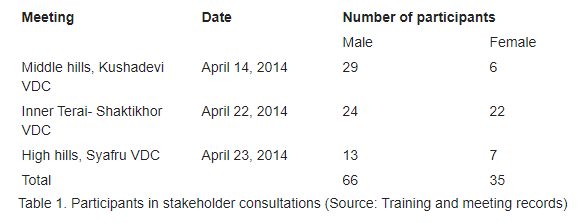
The team in consultation with local people identified the following general issues and threats:
- Absence of an institutional mechanism for biodiversity conservation at the local level;
- Weak institutional capacity to effectively manage biological resources and broader environmental issues;
- Inadequate awareness and knowledge gaps in biodiversity conservation;
- Over-harvesting and over-use of terrestrial biodiversity;
- Appearance of alien and invasive species;
- Excessive use of chemicals (pesticides, fertilisers) and fishing by poisoning and explosives;
- Loss of fresh water ecosystem and wetland habitats; and
- Lack of mainstreaming biodiversity in local economic development.
Phase 2: Constituting the biodiversity committee and defining roles
The visiting team (six forestry graduates and Team Leader) of KAFCOL, the project implementer, facilitated the formation of the biodiversity committee, known as an “Environmentally Friendly Local Governance Village Coordination Committee” (EFLGVCC), in each of the VDCs under the leadership of the VDC Secretary. Both in the high hills VDC (Syafru) and the middle hills VDC (Kushadevi) the EFLGVCC has seven committee members, and the Inner Terai (Shaktikhor) VDC has only four members (Table 2). The main role of the committee is to develop a biodiversity plan, implement it and to carry out observation and reporting to the VDC Secretary. Membership was defined based on local significance. For instance, buffer zone and national park staff were included in the committee of Syafru VDC, while the other two VDCs have members from the District Forest Office and Range Posts. In Kushadevi’s committee a local school teacher and a women’s group representative were included.

Phase 3: Biodiversity documentation and training
The first training workshop was held at the Dhulikhel Height Resort on 13 April 2014. The biodiversity committees were trained on how to develop LBSAP during the documentation process. Two research assistants (B.Sc. Forestry graduates) per site were involved in the documentation of biodiversity resources including resources available in forest and agricultural lands, immediately after the first training. Biodiversity resources are those species that are available for the community for a wide range of uses, primarily for their livelihood, but also those not directly used but which have other values such as cultural or recreational values. Species have been broadly classified into categories like cereals, vegetables, fruits, cash crops, livestock and many others. Data revealed that the highest biodiversity was found in Shaktikhor followed by the Kushadevi and Syafru VDCs with 442, 414 and 324 species, respectively. Species richness varied with altitude, water availability, agriculture practices and forest abundance in general.
Phase 4: Biodiversity issues and prioritisation
As a result of stakeholder consultations, eight main biodiversity issues and threats were identified. Specific threats from high hills included stealing of non-timber forest products (NTFPs) and medicinal and aromatic plants (MAPs) from common pool resources, expansion of rural roads, damage to agro-biodiversity by wildlife, poisoning of wildlife and insect/pest infestation. In addition, medicinal plant species such as Swertia chiraita,Valeriana jatamansi and Rheum australe were almost at the verge of extinction locally. In the middle hills, threats included extinction of local species (red grain wheat, Judi rice and Bhaudaure maize varieties), hybridisation, infrastructure development and chemical fertiliser use. Similarly in the Inner Terai (Shaktikhor), increased numbers of invasive species, loss of habitat, forest fires, use of hybrids and high use of chemical fertilisers were the high priority threats (SDM final report, 2014).
Phase 5: Development of LBSAPs and implementation
All three VDCs prepared their own LBSAPs based on the information prepared in the above four phases. As mentioned above, this report focuses on local capacity enhancement to improve biodiversity and livelihoods of Syafru VDC (high hills). We thus present the summary of the plan of this VDC only (Table 3). In the plan, six priority strategic issues have been identified (Table 3, column 1). Based on these issues, action points and funding sources have been indicated for each of the strategies. Of these six strategies, the following sections mainly focus on actions directly targeting medicinal plant conservation and livelihood improvement outcomes from the high hills area.

Methodology
To assess impacts related to biodiversity conservation and livelihood improvement outcomes of the LBSAP, we used a multi-pronged approach to collect relevant information. Both quantitative and qualitative information were collected in February 2014 and updated in February 2016 by KAFCOL, NAF and the IGES research team. This information was integrated and sequenced to enhance understanding of the impact situation of the project area at a two-year interval (i.e. 2014 and 2016). In 2014, a detailed household survey of 182 households was conducted including focus group discussions (FGDs) and key informant interview (KII) surveys. In 2016, only 37 selected households (Syafru: 21 and Ramche: 16 households) were interviewed and two FGDs and six KII surveys were conducted. KIIs were mainly with the staff of Langtang National Park, the District Forest Office and community leaders. Quantitative information was mainly collected from household surveys, and qualitative information was collected through FGDs and KII surveys. FGDs and KIIs mainly complemented the data collected from household surveys. Some of the questions included issues such as change in medicinal plant conservation and income, impacts on agriculture and forest resources, challenges faced, fear for the future concerning loss of biodiversity, and perceived benefits from domestication, as well as future plans of action.
Background on Syafru VDC
At an altitudinal range of 1700-4380 metres, Syafru VDC has a temperate climate in the upper hills and a subtropical to sub-temperate climate in the lower foot hills. A total of 621 households (HHs) reside here with the majority being Tamang, with some Sherpa and Dalit people. Men have a slightly higher population than women, 1,172 and 1,099 respectively. Major occupations are hotel business and agriculture. Pine and Rhododendron constitute the major forest types and agriculture is dominated by barley, millet, buckwheat, potato and maize. The cultivation of non-timber forest products (NTFP), especially Swertia chirayita, Paris polyphylla and Valeriana jatamansi, began a decade ago. The domestication of medicinal and aromatic plant species, particularly Swertia chirayita, known locally as Chiraito, in Syafru and Ramche VDCs of the Rasuwa District, was promoted as part of a project led by the Nepal Agroforestry Foundation (NAF), which is associated with the Kathmandu Forestry College. The farmers and other VDC stakeholders decided to incorporate and upscale the domestication of medicinal and aromatic plants (MAPs) as part of the KAFCOL-led LBSAP project.
A large part of this VDC’s area falls within the Langtang National Park and Buffer Zone. Syafru is one of the 18 VDCs of the Rasuwa district and lies in the central region of Nepal, which is also famous for Gosiankunda Lake that has both religious and environmental significance (Figure 1- Syafru VDC). Non-timber forest products (NTFP), including MAPs are at risk of theft from common lands, particularly the national park and community forest due to their high economic value. According to local traders, every year the complaints of theft have risen. Additionally, rampant collection and illegal trade of these MAPs/NTFPs have also increased the risk of extinction in the long run. Both the earlier NAF and the KAFCOL-led LBSAP projects have aimed at reducing the pressure on MAPs by supplying the market with plants that are cultivated on private farmland.
Project results and outcomes
Increased sufficiency and availability of MAP seeds and seedlings
Despite the initiation of domestication of MAPs over a period of five years (2004 to 2009) period, the MAP sub-sector supported only the self-reliance of local people. There was no marketing of MAPs. The seeds and seedlings were bought from outisde. The area was fragile and degraded. The cultivation of cereal crops was almost impossible. Therefore, the LBSAP’s priority was to increase self-sufficiency in seeds and seedlings of medicinal plants locally and to sell externally for household income. The project to develop and implement the LBSAP has made a significant contribution to the production and distribution of seeds and seedling of MAPs in the project area and has had a spillover effect beyond the project area. The number of home nurseries increased from 73 in 2014 to 122, almost double, in 2016 (Table 4). On average, these farm households produced 10,831 seedlings in 2014 and 19,831 seedlings per household in 2016 (Table 4), which is a significant contribution of the project in the promotion of medicinal plants on private lands.

Annually the project farmers produced 6.2 million seedlings in two VDCs. Additionally, the trained farmers and other individual farmers have also learned from the project and established home nurseries, which are believed to have increased conservation efforts by the farmers.
Local capacity enhanced in management of biodiversity resources
The project has made a significant contribution to enhancing the technical and managerial capacity of farmers in the management of community forest MAP resources and livelihood improvement. To encourage farmers towards the implementation of LBSAP and to enhance their skills and knowledge, the KAFCOL-led project held various training and consultation meetings as part of the LBSAP. This has enhanced the skills and knowledge of farmers. According to project staff and available reports during the final assessment, eight slots of MAP nursery management, cultivation and harvesting trainings were organised for about 100 famers from 2013 to 2014, and 393 farmers in 2015 and 2016.
Farmers’ group formation and institutionalisation is one of the important activities of the LBSAP project. Altogether 14 farmer groups per site were formed during the entire project period. About half of the members in farmer groups were female. While women were initially more reluctant to participate in the consultations, they became equally involved in project implementation, particularly as a result of their engagement in the documentation of biodiversity resources. An authorised executive committee comprising seven to eleven members with a chairperson, secretary, treasurer and other members was formed in each group with active participation and consensus of all stakeholder farmers. Altogether, 293 households (>50%) were organised into 28 local groups for conservation and domestication of biodiversity resources. The majority of farmers organised into groups were from marginalised ethnic groups including Tamang and Sherpa. An average of 22 households were organised into each group with a good mix of male and female headed households. The group members were trained on group dynamics, group functioning, coordination and domestication of MAP in their farmlands. These groups have formed a network of their own and are already registered into a cooperative per village. They are running saving credit programmes and marketing agricultural and forest products, particularly MAPs.
As a result of both the LBSAP development and implementation process and economic incentives from selling MAPs, a better sense of coordination and institutionalisation was observed among the users forming a good network in order to market the products and fetch more profit. The MAP federation has done risk and uncertainties analysis of their products and started addressing the risk. For instance, before the LBSAP was prepared, there were very few traders, and farmers had to depend on them to sell their products. Now they sell on their group’s behalf keeping some margin in their federation. Previously these benefits were diverted to a middle man. Every group is functional based on the group’s mandates and operational guidelines. Every decision is well recorded and endorsed in the presence of members and according to formal structures. All the farmers benefit equally because they have an equal share in the group.
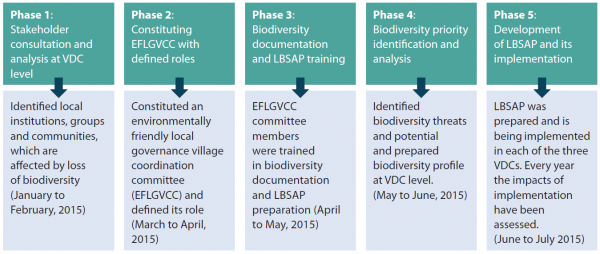
Figure 3. Many medicinal plants are found in one terrace riser
Increased MAP diversity in forests and farms
FGD held in Syafru and Ramche VDCs revealed that the LBSAP implementation has significantly contributed to the increase of medicinal plant diversity in forests and farms, particularly on medicinal plant species (such as Swertia chirayita (Chiraito), Valeriana jatamansi (Sugandhawal) and Rheum australe (Padamchal), Berginia ciliata (Pasanved) and Paris polyphylla (Satuwa), but also fodder and grasses (Leucaena diversifolia, Flemingia congesta, rai grass, cocks food), fruits, and other trees (e.g. walnut, ground and tree apples) (Figure 3). Swertia chirayita production is one of the main income generating activities (IGAs) of the farmers in the study area. Table 5 demonstrates that due to private land plantation, many species have been protected in community forests and national park areas.

Change in land use patterns among the project beneficiaries
People have gradually become motivated to cultivate MAPs in their private farmlands as an integral part of the farming system. Small changes in land use patterns have been observed among the project beneficiaries. Average land holding size of the project beneficiaries, including all types of land, was 10.4 Ropani, of which almost two Ropani (1.9 in Syafru) increase of MAP cultivation is a great contribution to preserving forest resources (Figure 4). This is attributed to the fact that farmers introduced wild MAP species in their barren and marginal land for increased production of MAP.
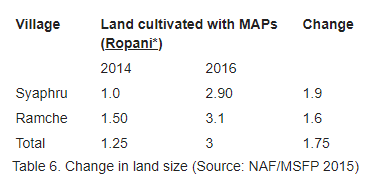
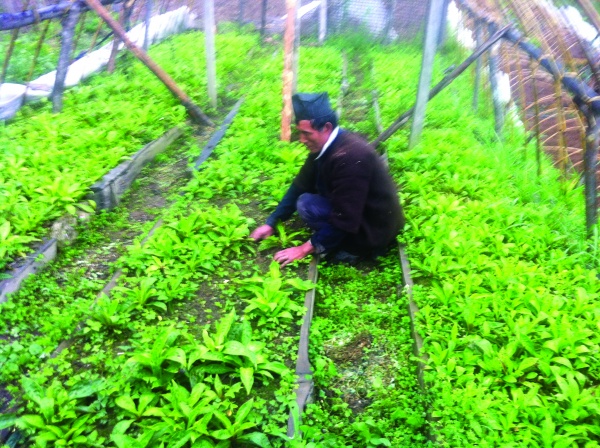
Figure 4. MAP nursery and cultivation area increased (Photo by Bishnu Hari Pandit)
Change in livestock herd size among the project beneficiaries
Except for large animals (buffalo and cattle), there has been a decrease in other herd sizes in the last two-year period. It is interesting to note that the overall livestock number per household remained the same (Table 7). This indicates that local people’s focus is now on MAP cultivation and whoever has increased his/her income from MAP sale, tends to increase the number of large animals as a matter of prestige. The herd size of buffalo has increased for milk production and sale along the Kathmandu-Dhunche transportation route. As the overall livestock number has not changed, impacts on the vegetation and overall biodiversity of the farmland, buffer zone and national park area are limited.

Change in level of food sufficiency at household level
Food sufficiency is measured counting the support from one’s own farm products and purchases with other cash income generated from sale of household level farm products. In 2014, ten percent of farm households could support food for only three months from their own products, a figure that declined to six percent in 2016 (Table 8).
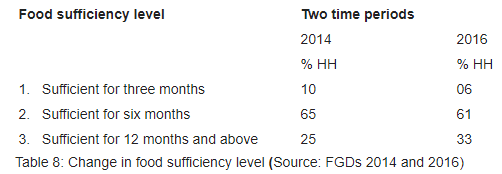
Similarly, 65 percent of farm households had food sufficiency for six months in 2014, while this share declined to 61 percent in 2016. More importantly, 25 percent of farm households in 2014 had food sufficiency for six months, a share which increased to 33 percent in 2016 (Table 8). Similarly, a significant change was observed in sources of income to complement the food deficit among the project beneficiaries; more than half of the farming households have changed their sources of income to reduce the food deficit (Table 9). Farmers reported that dependency on wage labour and working for tourists declined marginally, as household income was complemented by MAP and livestock income significantly. Farmers reported that the income from MAP and sale of livestock products has reduced the frequency of borrowing loans from relatives or neighbors and wage labour in 2016.
Change in household income among the project beneficiaries
Lorem ipsum dolor sit amet, consectetur adipiscing elit. Ut elit tellus, luctus nec ullamcorper mattis, pulvinar dapibus leo.The study revealed that average household income increased from NPR 147,843 in 2014 to 170,566 at current price (Table 9). An absolute increase of income by NPR 22,723 per household was mainly due to the sale of domesticated MAP. Other jobs, pensions, tourism, livestock and forest product income have also contributed to household economy. The mean income generated by households from NTFP/ MAPs was only NPR 25,021 in 2014, while it increased to NPR 45,943 in 2016, which is 92 percent of the total change. The first highest source of income change is from MAPs (27%) and second highest change in income is from remittance in 2016 (18%), followed by livestock (14%), jobs and pensions (10%) and tourism (8%). The increase in MAP income is attributed to the domestication of high value medicinal plants in private farmlands. This has reduced dependency on forests for collection of MAPs, which represents a mere one percent increase in 2016. The decrease in income from wage labour, food crops and remittance is an indication of the shift in the rural people’s livelihoods towards growing MAPs in their farmlands.
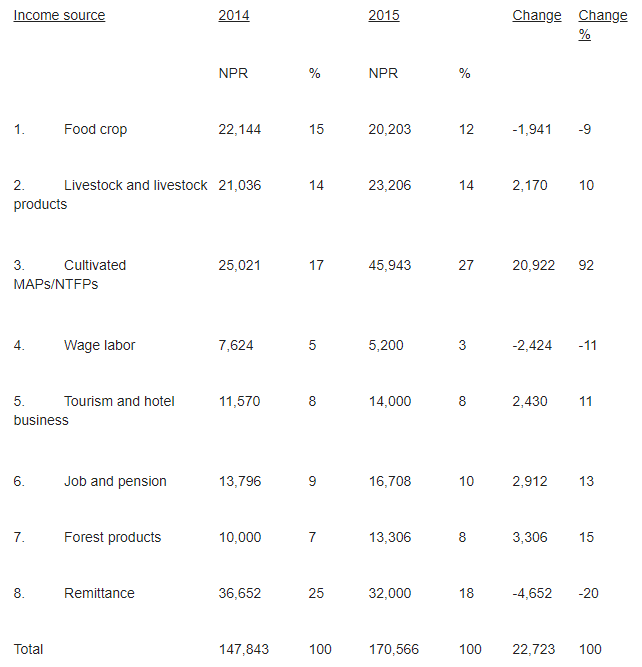
Table 9. Change in mean household income (NPR) in two time periods (Source: Field survey in 2014 and in 2015 by NAF)
Lessons learned and way forward
Lessons learned
It was observed that many rural households of the study area had migrated from their village due to fear of declining productivity two to three years ago. But now, they are slowly returning home due to the attraction that on-farm MAP production has developed. Therefore, polices should concentrate on optimising the environmental outcomes of the significant recent changes in household livelihood strategies. Integrated resource management plans that capitalise on the labour-migrant households’ lower dependency on agriculture and natural resources (e.g. programmes encouraging the conversion of marginal or abandoned farmland to high value forests) can enhance both rural people’s livelihoods and the sustainable use of existing resources. This is demonstrated by the fact that 120 farming households have their own home nurseries of medicinal plants.
The domestication of selected medicinal plants has significantly reduced the legal (i.e. authorised) and illegal collection of these and other MAPs in the protected areas and community forest. Locals are rarely involved in illegal extraction, but rather play an increasingly important role in reporting any cases of illegal collection by outsiders to the authorities. This is an indication of raised awareness among the local communities, and shows that the MAP domestication and its inclusion in the LBSAP has contributed to MAP conservation.
Despite an exciting improvement in food security over the years due to the integration of MAPs into the existing farming system, local communities are still suffering from shortages of food and periods of hunger. Therefore, there is still scope for increasing the medicinal plant cultivation areas to generate higher household income, which in turn decreases migration. However, it is important to take into account the importance of traditional practices as well as the protection needs of agro-biodiversity.
Before the LBSAP was developed, NAF as the initial project implementer had been promoting MAP domestication in this area, but these activities were not institutionalised. Likewise, the marketing of MAP products was done at an individual level. But with the development of LBSAPs, various stakeholders from the district level to the local (VDC) level have concentrated their efforts on both biodiversity conservation and the livelihoods of local communities. This has resulted in the establishment of a MAP cooperative network at the VDC level. Therefore, stakeholders’ commitment is very important for the success of the programme as it creates two main benefits: firstly, every stakeholder has a sense of ownership of the programme, and secondly, this commitment provides the institutional base to further promote the programme’s activities.
Way forward
Required follow-up steps include:
- There is a need to regularly follow-up on implementation and monitoring of the LBSAP;
- Forest and farm land inventories are needed for monitoring changes in biodiversity;
- Local government capacity strengthening activities are still required;
- The main stake and responsibility should rest on local government to implement a full phase LBSAP.
References
Arnold, JEM 1995, ‘Socio-economic benefits and issues in non-wood forest products use’, in Non-Wood Forest Products 3. Report of the international expert consultation on non-wood forest products, FAO, Rome, <http://www.fao.org/docrep/W7733E/w7733e07.htm- viewed in 5 June 2016>.
GoN/MoFSC (ed.) 2014, Nepal Biodiversity Strategy and Action Plan2014-2020, Government of Nepal, Ministry of Forests and Soil Conservation, Kathmandu, Nepal <https://www.cbd.int/doc/world/np/np-nbsap-v2-en.pdf> viewed in 28 May, 2016.
ICLEI, CBD and UNU-IAS 2011, Local Biodiversity Guidelines Underway, United Nations Decade on Biodiversity2011-2020, <https://www.cbd.int/doc/strategic-plan/UN-Decade-Biodiversity.pdf- viewed in 12 March 2014>.
KAFCOL 2014, ‘Local Biodiversity Strategy and Action Plan Syafru VDC’, draft submitted to Satoyama Initiative and Institute of Global Environment Strategies, Annex 2.5.1.
NAF/MSFP (ed.) 2015, ‘Final report submitted to Multi-stakeholder program’, Nepal Agroforestry Foundation, Kathmandu.
Pisupati, B 2007, Effective Implementation of NBSAPs: Using a decentralized approach- Guidelines for Developing Sub-National Biodiversity Action Plans, United Nations University Institute of Advanced Studies, Japan, <http://cbc.iclei.org/Content/Docs/LBSAP%20Guidelines.pdf- 20 March, 2016 >.
Pandit, BH, Adrian, A & Kumar, C 2009, ‘Community based forest enterprises in Nepal: An analysis of their role in increasing income benefits to the poor’, Small Scale Forestry, vol. 8, no. 4, pp 447-463.
Rasul, G, Choudhary, D, Pandit, BH & Kollmair, M 2012, ‘Poverty and livelihood impacts of a medicinal and aromatic plant project in India and Nepal’, Mountain Research and Development, vol. 32, no. 2, pp. 137-148.

